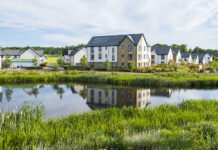
A group of experts in the transmission of airborne pathogens have called for a tightened regulatory system to control air quality in buildings.
The proposals would see the World Health Organisation create indoor air-quality guidelines that would act as recommendations to architects and builders on how to reduce the spread of airborne pathogens. Further to this would be the individual governments introducing and enforcing domestic regulations.
The cohort of scientists explained that current ventilation guidelines and standards focus on reducing odours and carbon dioxide levels and in maintaining thermal comfort, however said that none provide recommendations on how to control the spread of pathogens such as the flu and Covid-19.
They added that research conducted during the Covid-19 pandemic has underlined the role that aerosols play in spreading disease. When a person who has a respiratory infection speaks, coughs or sneezes, tiny infective particles are emitted from their nose and mouth – indoors, those particles are carried in the air and infect other people.
Among the 40 scientists is Cath Noakes, professor of environmental engineering for buildings at the University of Leeds and member of SAGE, the body which advises the UK Government on scientific emergencies.
Professor Noakes said, “Over the years, we have neglected the role that the air circulating inside a building plays in the way germs and viruses may spread between people. The pandemic has exposed that deficiency in our understanding and the way we seek to make buildings safer to use.
“We need to introduce new mechanisms that keep pathogen levels in the air flow in buildings and other enclosed spaces to a minimum. That approach can be achieved with technology backed-up with a requirement to meet new standards.
“Action to improve ventilation to reduce exposure to airborne pathogens will bring other benefits, including reducing exposure to other air pollutants and improved performance and wellbeing.”
Under the proposals, different standards would exist for the purpose of each building – with the required levels being different for that of a gym in comparison to a cinema, due to the different level of breathing in the two settings.
In a paper published in the journal, Science, the group wrote, “None of this means that every indoor space should become a biosafety facility. It means that a building should be designed and operated according to its purpose and the activities conducted there, so that airborne infection risk is maintained below an acceptable level.”
The paper continues by challenging the argument that costs of air quality control in buildings would be ‘prohibitively’ expensive. The scientists said that the monthly cost of Covid-19 is conservatively estimated at $1 trillion, with the installation of ventilation and air-quality systems designed to remove airborne pathogens adding about 1% to the construction costs of a typical building.
They added that improving air quality in buildings would bring benefits beyond just reducing sickness levels, but it is also ‘likely’ to reduce allergens and the number of people who experience ‘sick building syndrome’.











